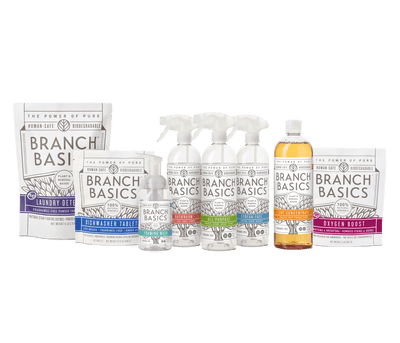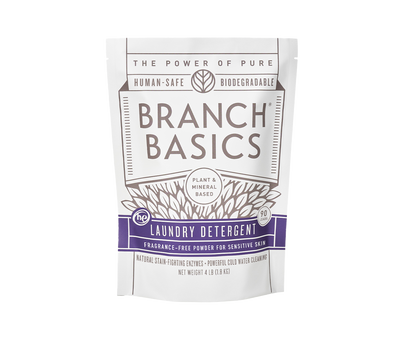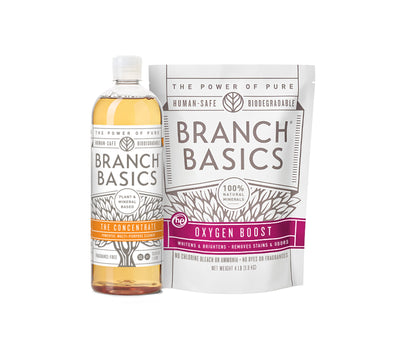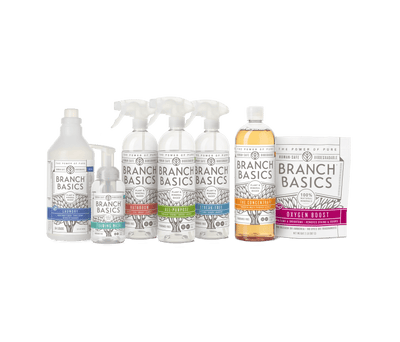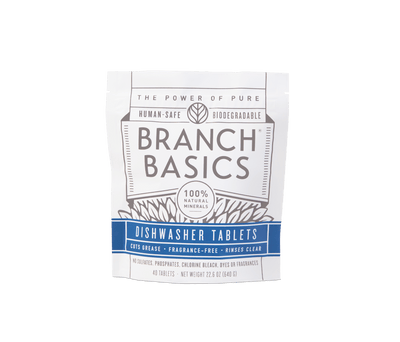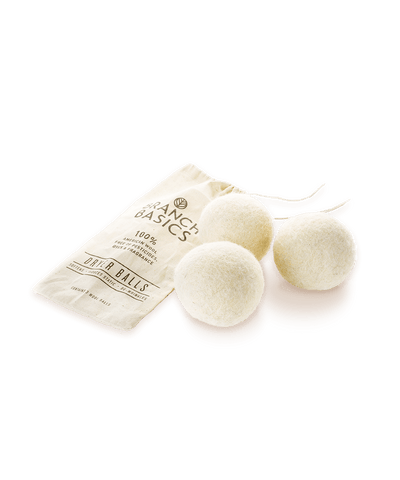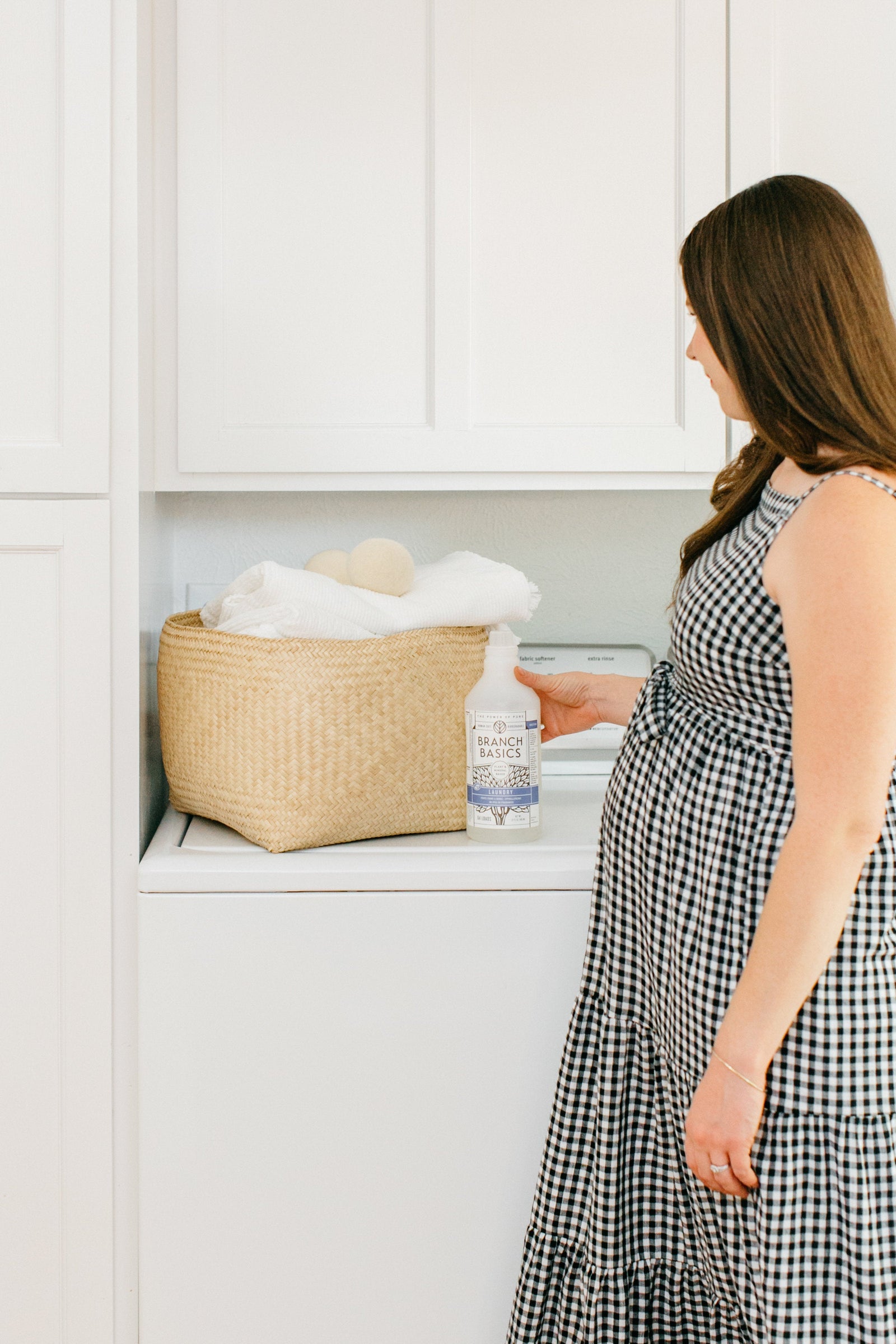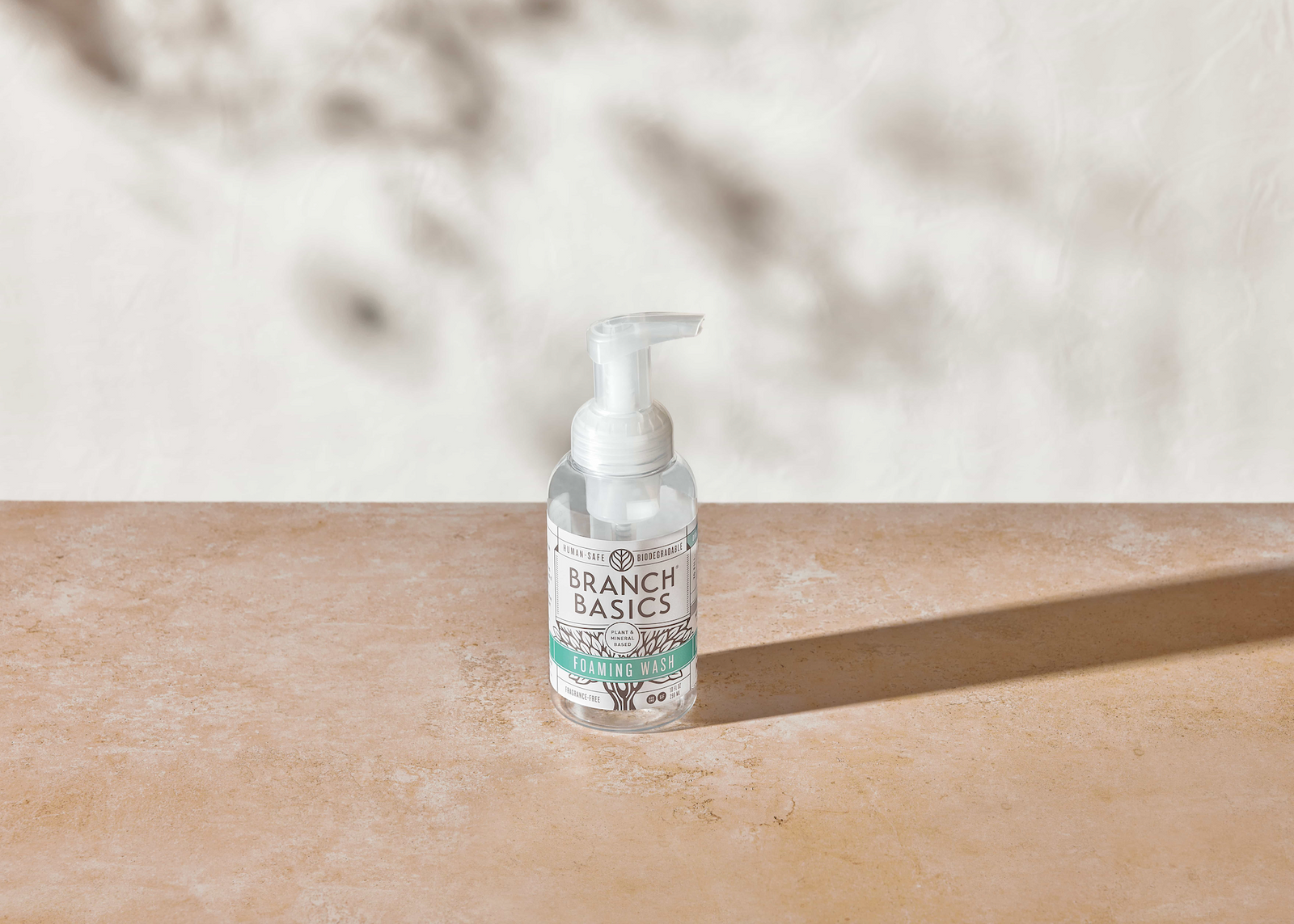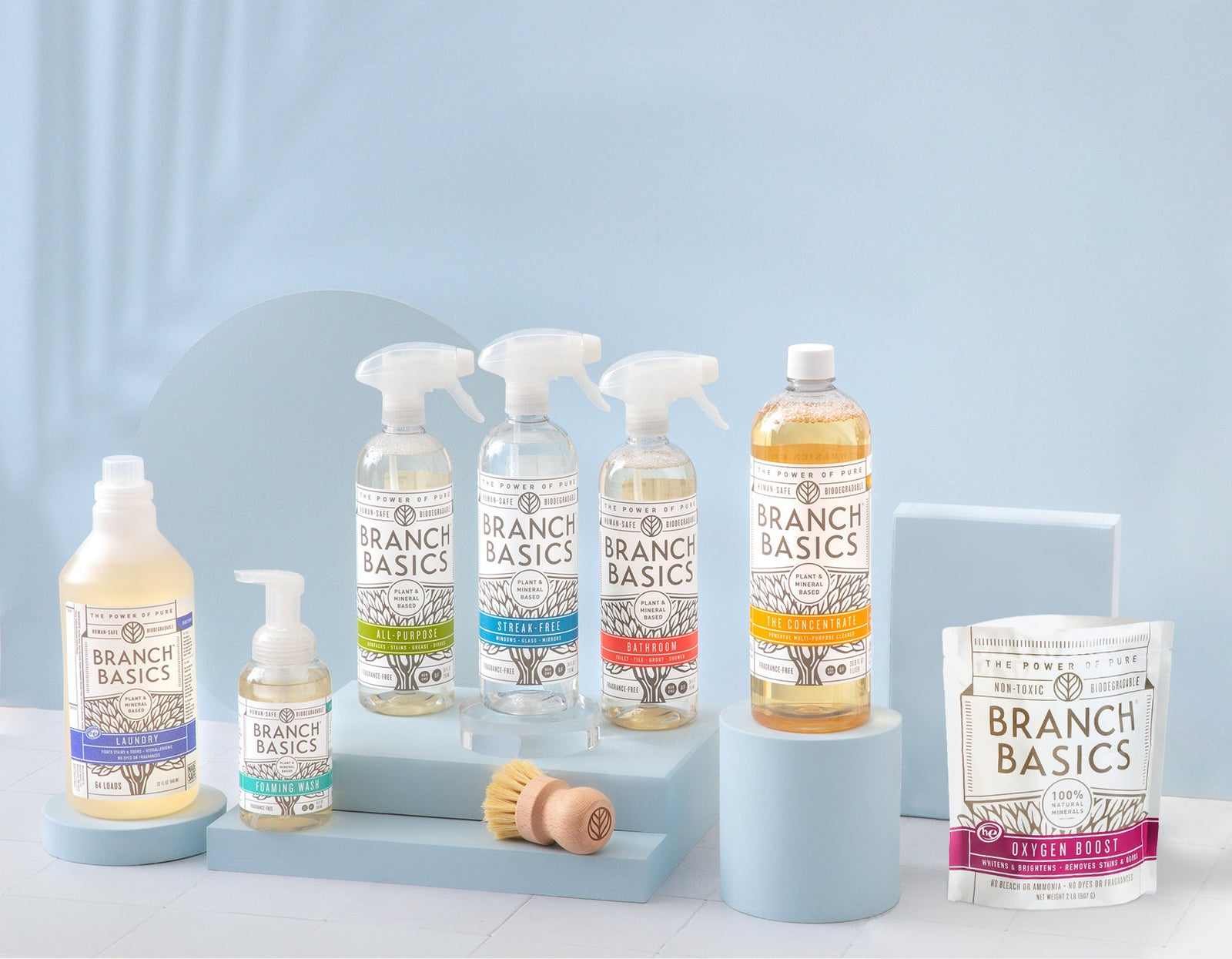Allergic to Cleaning Products at Work? Here's What to do

In most cases, we have the power to control what comes into our homes via cleaning products, food, personal care, pesticides, laundry products, etc.
This is important for anyone who wants to create a healthier home, but especially for those who have chronic illness, or are allergic or sensitive to cleaning chemicals and/or fragrance.
However, if you work outside the home, controlling exposure to these types of allergens and toxins can be a formidable challenge.
If you believe you may be allergic to or reacting to cleaning products at work, this article is for you.
Here we’ll discuss potential allergy or sensitivity triggers at work, including cleaning supplies, sources of mold, fragrance, and more.
You’ll also get empowered with resources and tools to approach your employer or building manager about your needs and how they can (and should) improve indoor air quality and eliminate products with harmful chemicals.*.
Potential Allergy Triggers at Work
If you find you’re more prone to headaches, fatigue, attention issues, mood swings, frequent sickness, and/or brain fog at work, chances are something within that environment is triggering you.
A trigger like this could cause an allergic reaction, such as hives, sneezing, wheezing, itchy eyes, skin rash, etc. or a more subtle inflammatory response, such as a headache, fatigue, or tendency to catch every bug that goes around the office.
However, in many cases, it may not be a true allergic reaction with an immune response, but a reaction on the cellular level to an exposure to toxic chemicals!
The following are some of the most common potential allergy or toxic sensitivity triggers at work to consider.
Toxic Cleaning Supplies
The vast majority of workplaces, including schools and universities, employ cleaning crews that use commercial cleaning products made with a toxic soup of synthetic chemicals. It is important to realize that these products are harmful to everyone and while some reactions can be an actual allergic reaction, most of the time it is the body, in its wisdom, sounding an alarm, warning of harm.
Many ingredients in these products can cause actual allergic reactions or sensitivities as well as a response on the cellular level, including:
1. Fragrance
Fragrance tops our list because it’s one of the world’s top allergens and is almost ubiquitous in workplaces.
From scented cleaning products to air fresheners to strong-scented laundry detergent and perfumes wafting off co-workers, it’s tough to get away from fragrance at work.
The problem is fragrance chemicals—of which there are thousands—are a significant source of VOCs (which you’ll learn about next) that create sick building syndrome.
For instance, just one signature fragrance used in an office bathroom air freshener can contain dozens or hundreds of undisclosed chemicals, many of which are allergens, carcinogens, neurotoxins, obesogens, asthmagens, endocrine-disruptors, and are designated “toxic” or “hazardous.”
Allergic reactions or sensitivity to fragrance chemicals may include:
- Congestion
- Dermatitis, hives, skin rashes
- Dizziness or fainting
- Headaches and migraines
- Gastrointestinal issues
- Neurological effects
- Respiratory problems, including coughing, difficulty breathing, and asthma symptoms
- Watery eyes
This is likely not news to many of you, as millions of people report symptoms of headache, fatigue, nausea, brain fog, or congestion after exposure to fragrance.
If you’re lucky, your building may have a fragrance-free policy. If not, we’ll discuss how to make that happen, coming up.
Learn more about fragrance chemicals and how to avoid them in:
- Fragrance Is The New Secondhand Smoke | Eliminate Synthetic Fragrance To Improve Your Health
- The Best Fragrance-Free Cleaning Products And Alternatives
- How To Get Heavy Fragrance Out Of Clothing
2. VOCs (Volatile Organic Compounds)
When you smell anything, from a fresh flower to a cleaning product, you are inhaling VOCs.
While natural VOCs found in nature, like the smell of a rose, are typically not a problem, many VOCs that are emitted from products are harmful, especially if inhaled frequently or when allowed to accumulate in poorly ventilated indoor spaces (and when was the last time you were able to open windows at work?), where they cause sick building syndrome.
Research has shown cleaning products, including “green” brands*, are a primary source of VOC pollutants. The same goes for fragranced products, which are very common in workplaces.*According to the Environmental Protection Agency, VOC exposure can cause the following reactions and sensitivities:
- Allergic skin reactions
- Brain fog or cognitive impairments
- Damage to the liver, kidneys, and central nervous system
- Dyspnea (feeling as though you cannot catch your breath)
- Dizziness
- Eye, nose, and throat irritation
- Headaches
- Loss of coordination
- Nausea
- Nosebleeds
- Respiratory issues, especially for those with asthma or other lung conditions
- Shortness of breath
- Vomiting
Certain VOCs are also suspected or known carcinogens, and long-term effects can include increased risk of asthma, bone marrow disorders, and central nervous system damage.
Common VOCs in cleaning products include:
- Chlorine bleach
- Ethylene oxide
- Formaldehyde and formaldehyde donors
- Fragrance
- Glycol ester
Scented cleaning and laundry products, including detergents, fabric softeners, and stain removers, are also a significant source.
So, if you work in or near a laundry facility, such as a hotel, spa, hospital, or resort, this is something to consider.
Related Read: What Are VOCs And How Do They Affect Your Health?
3. Bleach
Bleach is one of the most common and toxic synthetic chemicals used in commercial cleaning products.
It's also an allergen, an EPA-registered pesticide, and a VOC pollutant. Therefore, bleach is poisonous and undermines the health of all people, especially anyone with allergies, asthma, chronic illness, or chemical sensitivities.
Yet, it is ubiquitous in synthetic cleaning products to clean and disinfect workplaces, schools, gyms, pools, and public buildings.
If you suffer from allergies, lung issues, or sensitivities, do not discount the impact of bleach exposure.
Learn more about why bleach is so harmful in: Is Sodium Hypochlorite (Bleach) Toxic?
4. Ammonia
Ammonia is another common chemical used in cleaning products as well as food processing, pharmaceuticals, and industrial agriculture.
It’s no secret ammonia is toxic when inhaled or ingested and is a severe skin and eye irritant.
Ammonia, when combined with bleach, also creates a deadly gas. Many people know this, yet these two cleaners are often used simultaneously.
For example, an ammonia-based glass cleaner and bleach-based toilet bowl cleaner may be used at the same time in an office bathroom with little to no ventilation.
Ammonia exposure via inhalation, skin or eye contact, or ingestion can result in the following reactions or symptoms:
- Blindness and irreparable eye damage
- Bronchiolar and alveolar edema and airway destruction resulting in respiratory distress or failure (death)
- Corrosive damage to the mouth, throat, and stomach
- Coughing, and nose and throat irritation
- Difficulty breathing
- Drooling
- Frostbite injury
- Hives
- Immediate burning of the nose, throat and respiratory tract
- Irritation or damage to the mucous membranes
- Liver, gastrointestinal, and kidney damage
- Rapid skin and eye irritation
- Severe injury and burns to eyes and skin
- Skin rashes
- Wheezing
To learn more about ammonia in cleaning products—including why it’s totally different from ammonia made by our bodies, see: 5 Ammonia-Free Cleaning Products.
5. Formaldehyde
This is a tough one because formaldehyde exists in many cleaning products and office products, such as office furniture made from particle board.
In cleaning products, formaldehyde is used as a slow-release preservative, known as formaldehyde donors, and it’s not very obvious on labels.
Formaldehyde is a known carcinogen, a VOC, and a lung irritant, and exposure can cause various allergic reactions, symptoms, and even death.
It’s also a universal sensitizer, which means it can enhance your sensitivity to all chemicals.
Allergic reactions to formaldehyde may include: [Sources 1, 2]
- Anaphylactic reactions
- Asthma
- Dermatitis
- Difficulty breathing
- Eye, skin, and nose irritation
- Fatigue
- Insomnia
- Mental confusion
- Nosebleeds
- Upper respiratory tract irritation and inflammation
- Skin rash
Anyone with asthma or hyper-reactive airways (10-20% of the U.S. population) is especially susceptible to formaldehyde.
Common names for formaldehyde-based preservatives (aka: formaldehyde donors), include:
- 2-bromo-2-nitropropane-1,3-diol
- Bromopol
- Diazolidinyl urea
- DMDM Hydantoin
- Imidazolidinyl urea
- Polyoxymethylene urea
- Sodium hydroxymethyl glycinate
- Quaternium-15
It is also worth noting that terpene-containing essential oils (pine and citrus) can react with ozone in the air and produce formaldehyde.
This is something to pay attention to if you live in an area with ozone alerts or work in a space with ozone-emitting devices and poor ventilation, such as laser printers, ozone air purifiers, electrostatic filters, or UV lights in the HVAC system.
In this case, allowing essential oil diffusers at work may be causing increased indoor air pollution.
Get more information on how to avoid formaldehyde at work and at home in: 23 Sources of Formaldehyde to Remove from Your Home, Starting Right Now.
6. Glycol Esters
Glycol esters used in cleaning products, such as ethylene glycol, polyethylene glycol (PEG), 2-butoxyethanol, and glycol ether are used to loosen and trap dirt on surfaces and act as wetting agents.
They are found in numerous cleaning products, including all-purpose cleaners, window and glass cleaners, and laundry products, and can cause allergic reactions and hypersensitivity, including eye and skin irritation or damage and respiratory symptoms.
The really concerning issue is that glycol esters are also reproductive toxins that can affect DNA, making their use risky for pregnant women and their unborn babies.
This is not an exhaustive list of all the cleaning chemicals that can cause allergic reactions.
However, it does highlight some of the worst offenders and how harmful they can be when you’re exposed to them day after day at work (or at home, school, etc.).
AC & Heat Systems
If you notice allergies or other symptoms like watery eyes, sneezing, congestion, or a dip in immunity when the heat or A/C goes on at work, it could be your building’s HVAC system.
HVAC systems are notorious for harboring mold, mildew, and other allergens, especially if they aren’t cleaned and maintained properly (including ducting) or housed in an area containing mold.
Carpeting
Many offices opt for carpets to save money and help dampen noise.
However, carpets absorb everything that falls or is tracked onto them, including:
- Allergen-containing dust
- Indoor and outdoor air pollutants
- Bacteria
- Viruses
- Fungi
- Mold
- Mildew
- Pet hair
- Dander
- Pesticides
- Herbicides
- And whatever is tracked in on everyone’s shoes (heavy metals, feces, urine, pesticides, etc.).
Vacuuming, regular carpet cleaning, and an indoor-shoes policy can help.
However, unless the cleaning crew is using a HEPA vacuum, pollutants are being released back into the air. And carpet cleaners contain various harsh chemicals that linger, especially in poorly ventilated areas.
Related read: The Best Vacuums For Non-Toxic Living: The HEPA Difference.
Faulty Air Filtration
If your building’s facility maintenance team is on it, they should be changing HVAC air filters at least once a month or more, depending on the size of the building and the number of employees.
These simple air filters can make a world of difference in catching dust, pollen, and other contaminants, so long as they are changed frequently.
If this is neglected, it can cause a significant dip in indoor air quality which can result in an uptick of allergy or sensitivity symptoms.
Some more modern buildings have installed indoor air purification systems, which is a positive step in the right direction, so long as they are maintained.
Perfumes And Colognes
Perfumes and colognes are filled with allergens from synthetic fragrance chemicals, VOCs, petroleum products, and other harmful ingredients—some of which are classified as endocrine disruptors, obesogens, asthmagens, neurotoxins, carcinogens, and hazardous substances.
Most people don’t realize this and wouldn’t wear them if they knew the truth. Unfortunately, their perfumes and colognes have negative consequences for everyone else, especially those with allergies or sensitivities.
The same goes for scented lotions, soaps, detergents, aftershave, and other products that emit a strong fragrance.
These days, it is not uncommon for workplaces to adopt fragrance policies to help mitigate the secondhand-smoke-like effects of perfumes, colognes, and other fragrance.
More on this to come.
Poor Ventilation
One of the best ways to improve indoor air quality is by opening windows.
Unfortunately, most office spaces do not have windows that open and therefore, have incredibly poor ventilation.
This allows toxins, allergens, and contaminants to accumulate over weeks, months, and years as they slowly degrade indoor air quality.
According to the Centers for Disease Control:
“Good ventilation is essential to maintaining a healthy indoor environment and protecting building occupants from respiratory infections. It can also help reduce the number of viral particles in the air and lower occupants’ risk of exposure to respiratory viruses.”
Improving ventilation typically requires an investment, however there are many solutions available for forward-thinking building owners.
Check out the EPA’s Clean Air In Buildings Challenge for more information targeting business owners.
How To Advocate For Your Allergies and Toxic Concerns At Work
Now that you know what types of products can trigger allergies and sensitivities, let’s look at some solutions for creating a healthier work environment.
A word of encouragement: although this may seem like a tall task, by taking action, you’re not only helping yourself, you’re helping every other person in your workplace avoid harmful toxins (whether they notice them or not).
Plus, it is not uncommon for workplaces to adopt things like fragrance policies, which limit the use of fragranced cleaning products or personal fragrance products at work.
Bottom line, it is not unusual or inappropriate to ask for help dealing with work-related allergens any more than it would be to bring up other issues related to physical, mental, or emotional well-being at work.
Companies have a responsibility to protect the health of their employees, but they may not be aware of these issues unless someone brings it to their attention.
By doing so, you’re being a champion for yourself and your co-workers.
Identify The Source
If you feel your workplace’s cleaning products and procedures are hindering your health, the first step is to identify the source of the symptoms.
Fortunately, you’re not starting from square one! With what you’ve learned in this article, you already have a perfect starting point to begin your investigation.
If you suspect cleaning chemicals are the culprit, ask what types of cleaners are used around the office, look around for sources of fragrance (plug-ins, air fresheners in bathrooms, etc.), and check toilets for automatic toilet bowl cleaners.
If you suspect a deeper issue, such as mold or mildew, it’s time to have a chat with your manager and the maintenance crew.
Chat With Your Manager or HR Director And Building Maintenance Crew
Typically, the best place to start sharing your concerns is with your manager, HR director, or supervisor.
A significant part of their job is to create a healthy and productive work environment. Therefore, they should be open to hearing your concerns.
Start by sending an email documenting your symptoms, how they are affecting your work experience or performance, and why you believe they are related to office cleaning products and policies, fragrance, or other issues such as mold, poor ventilation, etc., and ask for a meeting to discuss.
During the meeting, re-share your concerns along with a list of possible solutions, such as:
- Implementing a fragrance policy
- This article from Job Accommodation Network has some excellent advice and templates
- Examining which cleaning products are being used and showing them healthier alternatives
- Switching to human-safe cleaning products, like Branch Basics
- If companies request a cleaning company use healthy products, they typically just need to supply them. Click here to shop Branch Basics Starter Kits, which have everything needed to replace all the synthetic cleaning products in your office.
- Keeping humidity at less than 50% to discourage mold
- Implementing an indoor shoe policy, where employees change into indoor shoes at work to reduce the spread of contaminants
- See and share: Why We Keep A No-Shoes Indoors Policy for some pretty shocking science detailing what’s tracked indoors on shoes
- Starting a healthy office committee
- Bringing in toxin-absorbing plants
- As detailed in: The Benefits Of House Plants For Cleaner Air And Better Health, species such as rubber trees, peace lilies, and spider plants have been shown effective in a NASA study for removing VOCs, formaldehyde, and more. Plants have also been shown to boost cognitive performance, improve mood, lower stress, and increase happiness!
- Encouraging regular dusting by providing human-safe, bleach-free wipes to employees to wipe down desks, computers, surfaces, etc.
- Installing an air purification system or providing stand-alone units for offices and common spaces
- See How To Choose An Air Purifier For Your Home for recommended brands
- Improving ventilation by opening windows and doors and/or investing in fresh air technologies (here’s that link to the EPA Clean Air In Buildings Challenge)
- Having maintenance change out air filters more frequently
- Investing in HEPA vacuums for the cleaning crew
This shows you’re invested in helping affect change. Make sure you email this list to your manager or supervisor as well.
Once you’ve talked to the manager, they can relay your concerns to their bosses and communicate with the building maintenance crew.
If you don’t hear back about your meeting, be sure to politely follow up until you’re certain these issues are being addressed.
Get more tips and solutions you can apply to your workplace in: How To Educate Schools On Safer Cleaning (Without Sounding Crazy).
Talk With Others, There Is Power In Numbers!
If you’re experiencing unwanted allergy or sensitivity symptoms at work, it is likely others are having the same problem.
The best way to find out is to ask questions and talk about it.
If you’re committed to approaching these discussions in the spirit of creating resolution and ideas versus complaining and harboring discontent, there can be great power in numbers.
This can also be an excellent way to vet members for a future healthy office committee.
Related read: Work Day Hacks: How To Make Your Day Healthy And Productive.
Find What Solution Works Best For You
The best solution for addressing allergies to cleaning products at work depends on the individual and the company.
Some companies may be very open to changing or amending their policies, while others may require more convincing or effort from you.
One area you can always address is your own workspace by:
- Avoiding using fragrances (or wearing them)
- Bringing in an air purifier and/or opening windows if possible
- Bringing your own cleaning products and hand soap to clean your personal workspace
- Branch Basics Travel Size Kit is ideal for this and comes with everything you need to make a mini All-Purpose spray for cleaning surfaces and Foaming Wash for handwashing
- Wearing indoor shoes at work
- Communicating to others about your allergies or sensitivities, especially if they use air fresheners or perfume
- Dusting frequently
- Decorating with toxin-absorbing plants
- Opening windows, if available
- Using a small air purifier near your desk, cubicle, or office
- See: How To Choose An Air Purifier For Your Home for recommended brands.
Related Read: Home Cleaning Guide For Allergy Sufferers.
Allergy-Friendly Cleaning Products
One of the most effective ways to eliminate toxic cleaners at work is to do the heavy lifting for your employer.
We’ve found gifting your employer (or school) a Branch Basics Starter Kit to provide for the cleaning crew is a very effective way to show them how easy (and economical) it is to make the switch.
Our Cleaning Essentials Starter Kits (available in refillable glass or plastic) provide everything needed to replace every unsafe cleaning product with just one safe & effective Concentrate, including:
- Streak-Free: For windows, glass, stainless steel, and more
- All-Purpose: For countertops, desks, surfaces, kitchens, spot-cleaning carpets, and everything in between
- Bathroom: For all things bathroom
For more information on how Branch Basics human-safe cleaning system works, plus a video demo, see: How To Get Started With Your Branch Basics Kit.
Finally, don’t give up! With patience and polite persistence, you can make a world of difference while raising awareness about the importance of a healthy office space.

Marilee Nelson
Marilee Nelson is an Environmental Toxins expert who has spent nearly 30 years advocating for the chemically-sensitive and chronically-ill. She is a Board Certified Nutritionist, Certified Bau-Biologist and Bau-Biology Inspector and specializes in Food As Medicine. She has helped thousands of families and individuals identify, heal and recover from toxic exposures and is on a mission to revolutionize the way American families view their health.
